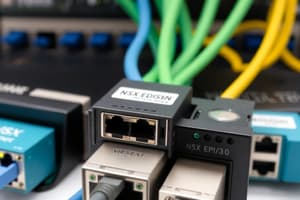Podcast
Questions and Answers
What is essential for maintaining service continuity in system management?
What is essential for maintaining service continuity in system management?
- Developing advanced coding scripts
- Upgrading hardware every year
- Avoiding regular system checks
- Implementing data protection strategies and recovery procedures (correct)
Which aspect should be prioritized when troubleshooting NSX Edge cluster configurations?
Which aspect should be prioritized when troubleshooting NSX Edge cluster configurations?
- Write custom monitoring scripts only
- Utilize troubleshooting protocols and tools that consider configuration intricacies (correct)
- Update the firmware regularly
- Replace all old components
Why is effective monitoring essential for NSX Edge clusters?
Why is effective monitoring essential for NSX Edge clusters?
- To detect potential issues and maintain optimal performance (correct)
- To avoid collecting metrics altogether
- To only review performance once a year
- To ensure quick hardware replacement
What must be carefully managed regarding licensing for vSphere and NSX?
What must be carefully managed regarding licensing for vSphere and NSX?
What should be assessed to ensure proper interoperability with NSX Edge clusters?
What should be assessed to ensure proper interoperability with NSX Edge clusters?
What is critical to plan for in regards to NSX Edge cluster updates?
What is critical to plan for in regards to NSX Edge cluster updates?
What should a comprehensive deployment strategy include?
What should a comprehensive deployment strategy include?
What is a specific consideration for deploying using vSphere 5.2?
What is a specific consideration for deploying using vSphere 5.2?
What might result from improper data protection implementation?
What might result from improper data protection implementation?
Why is it important to plan for downtime during upgrades?
Why is it important to plan for downtime during upgrades?
What is the minimum version requirement for vCenter Server to deploy an NSX Edge cluster?
What is the minimum version requirement for vCenter Server to deploy an NSX Edge cluster?
Which of the following is NOT a requirement for ESXi hosts in an NSX Edge cluster deployment?
Which of the following is NOT a requirement for ESXi hosts in an NSX Edge cluster deployment?
Why is it important to validate NSX Edge services after configuration?
Why is it important to validate NSX Edge services after configuration?
What must be configured to protect the NSX Edge cluster from unauthorized access?
What must be configured to protect the NSX Edge cluster from unauthorized access?
Which statement is true regarding network requirements for NSX Edge deployment?
Which statement is true regarding network requirements for NSX Edge deployment?
What is a crucial aspect of backup and recovery for the NSX Edge cluster?
What is a crucial aspect of backup and recovery for the NSX Edge cluster?
Which practice ensures network security for the NSX Edge cluster?
Which practice ensures network security for the NSX Edge cluster?
How should ESXi host firewall rules be configured for NSX traffic?
How should ESXi host firewall rules be configured for NSX traffic?
What is the implication of network bandwidth availability for the NSX Edge cluster?
What is the implication of network bandwidth availability for the NSX Edge cluster?
Which of these is considered a necessary network service for an NSX Edge cluster to function?
Which of these is considered a necessary network service for an NSX Edge cluster to function?
Flashcards
vCenter Server Requirement for NSX Edge
vCenter Server Requirement for NSX Edge
vCenter Server version 5.2 or higher is mandatory for deploying an NSX Edge cluster, including the required NSX licensing. vCenter Server needs sufficient resources like CPU, memory, and storage to handle the load of the NSX Edge cluster.
ESXi Host Requirements for NSX Edge
ESXi Host Requirements for NSX Edge
ESXi hosts must be running version 5.2 or higher. They must have enough allocated resources (CPU, memory) for NSX components. Network adapters need proper configuration for NSX connectivity and communication. Applying ESXi patches and updates is essential for compatibility and security. Configuring ESXi host firewall rules correctly is vital to allow NSX traffic.
Network Requirements for NSX Edge
Network Requirements for NSX Edge
A dedicated network (physical or virtual) is required for NSX management traffic. Reliable connectivity between vCenter Server and ESXi hosts is crucial. Necessary network services like DNS and DHCP must be functional. Sufficient bandwidth is needed for NSX Edge cluster communication and operations.
NSX Edge Component Configuration
NSX Edge Component Configuration
Signup and view all the flashcards
Security Considerations for NSX Edge
Security Considerations for NSX Edge
Signup and view all the flashcards
Backup and Recovery for NSX Edge
Backup and Recovery for NSX Edge
Signup and view all the flashcards
Troubleshooting Protocols
Troubleshooting Protocols
Signup and view all the flashcards
Monitoring Mechanisms
Monitoring Mechanisms
Signup and view all the flashcards
Key Metrics
Key Metrics
Signup and view all the flashcards
vSphere Licensing
vSphere Licensing
Signup and view all the flashcards
Interoperability Assessment
Interoperability Assessment
Signup and view all the flashcards
Upgrade Planning
Upgrade Planning
Signup and view all the flashcards
Deployment Strategy
Deployment Strategy
Signup and view all the flashcards
vSphere 5.2 Compatibility
vSphere 5.2 Compatibility
Signup and view all the flashcards
NSX Edge Cluster Deployment
NSX Edge Cluster Deployment
Signup and view all the flashcards
Smooth and Functional Solution
Smooth and Functional Solution
Signup and view all the flashcards
Study Notes
NSX Edge Cluster Deployment in vSphere 5.2 - TEP Requirements
- Specific Technical Engineering Practices (TEPs) are required for deploying an NSX Edge cluster in vSphere 5.2. Compliance ensures optimal network performance, security, and stability.
- vCenter Server version 5.2 or higher is needed, including NSX licensing. Appropriate provisioning for the cluster load is essential.
- ESXi hosts running version 5.2 or higher are required. Sufficient resources (memory, CPU) for NSX components are necessary. Network adapters must be configured for NSX connectivity. Apply ESXi patches and updates. Configure ESXi host firewalls for NSX traffic.
- A dedicated physical or virtual network is needed for NSX management traffic. Reliable connectivity between vCenter Server and ESXi hosts is critical. Configure necessary network services (DNS, DHCP) for cluster operation. Required network bandwidth must be available.
- Correctly configure NSX Edge cluster parameters (nodes, resources) for optimal performance. Validate NSX Edge services (logical switches, routing). Configurations must ensure proper traffic flow, security policies, and access control lists (ACLs).
- Deploy appropriate network security policies to protect the cluster from unauthorized access. Secure configurations for all components are mandatory. Adhere to security best practices (strong passwords, data encryption).
- Establish backup and recovery strategies for the cluster configuration and data. Implement data protection and recovery procedures for service continuity.
- Develop troubleshooting protocols and tools for cluster configurations. Implement effective monitoring mechanisms for issue detection/resolution. Monitor cluster performance and resource utilization to proactively manage health.
- Ensure proper vSphere and NSX licensing. Adhere to licensing terms.
- Assess interactions with other networking components to guarantee interoperability. Validate any integrations using the cluster.
- Plan for upgrades and validate compatibility with the vSphere version. Plan for any potential downtime during upgrade procedures.
- Establish a comprehensive deployment strategy. Validate the entire deployment process thoroughly.
Specific vSphere 5.2 Considerations
- Assess vSphere 5.2 features for NSX Edge cluster deployment.
- Ensure full compatibility between vSphere 5.2 components and NSX to avoid issues.
Studying That Suits You
Use AI to generate personalized quizzes and flashcards to suit your learning preferences.


